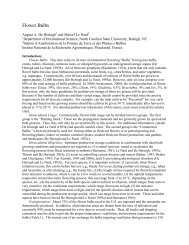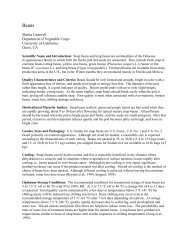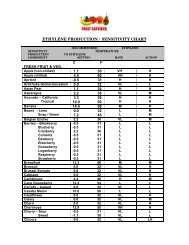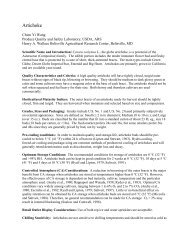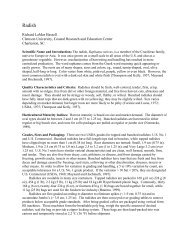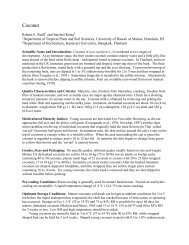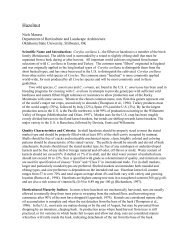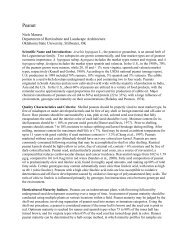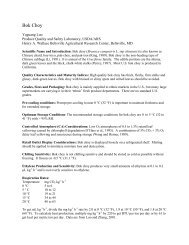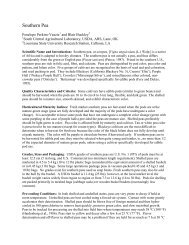Rutabaga
Rutabaga
Rutabaga
Create successful ePaper yourself
Turn your PDF publications into a flip-book with our unique Google optimized e-Paper software.
<strong>Rutabaga</strong><br />
Maria Cecilia do Nascimento Nunes<br />
Department of Soils and Agrifood Engineering<br />
Laval University, Quebec, Canada<br />
Scientific Name and Introduction: <strong>Rutabaga</strong> (Brassica napus L.; Napobrassica group), also referred as<br />
swedes, Swedish turnips, and turnip-rooted cabbage, is a member of the Cruciferae. The edible portion is<br />
the large, usually yellow-fleshed storage root. The three main commercial varieties of rutabagas include<br />
American Purple Top, Laurentian, and the Thomson Strain of Laurentian. <strong>Rutabaga</strong> is a cool season<br />
vegetable that withstands frost and mild freezing. In North America, rutabaga is primarily grown in<br />
Canada, California, Colorado, Wisconsin and Minnesota.<br />
Quality Characteristics and Criteria: A high quality rutabaga is a well-shaped, purple-top root that has<br />
a smooth, small neck, and a well-defined taproot with a minimum of side roots, and is free of blemishes<br />
and bruises. The roots should be firm, fresh looking, sweet and not bitter, and heavy for their size.<br />
Lightweight rutabagas may be “woody” (Gardner and Nonnecke, 1987).<br />
Horticultural Maturity Indices: <strong>Rutabaga</strong>s should be harvested when fully mature, since immature<br />
rutabagas can have a bitter taste. Good quality rutabagas are harvested when maximum sugar<br />
accumulation has occurred. Winter crops should be harvested before weather becomes hot, or roots<br />
become pithy and woody. Harvesting Fall crops after the first frost can sweeten flavor (Suzuchi and<br />
Cutcliffe, 1981).<br />
Grades, Sizes and Packaging: Grades include U.S. No. 1 and U.S. No. 2, based on subjective external<br />
appearance. Sizes are defined as Small, (diameter of 5.1 to10.2 cm; 2 to 4 in); Small-Medium (8.9 to 14<br />
cm; 3.5 to 5.5 in); Medium (10.2 to 15.2 cm; 4 to 6 in); and Large (13 to 17.8 cm; 5 to 7 in). Common<br />
packaging is 23 kg (50 lb) bushel cartons or bags (about 20 roots) and 11 kg (25 lb) 0.5-bushel cartons<br />
(about 10 roots).<br />
Pre-cooling Conditions: Roots should be cooled as quickly as possible in order to avoid excessive<br />
moisture loss. Brown surface discoloration called ‘storage burn’ can be largely controlled by rapid<br />
cooling at 0 °C (32 °F) together with adequate air circulation (Franklin and Lougheed, 1975). If<br />
harvested when the soil or air is above 25 °C (77 °F), they should be cooled within 3 to 4 h to avoid loss<br />
of quality during storage. Room-cooling is most commonly used, however, forced-air cooling, hydrocooling<br />
and package-icing can also be used to retard development of skin discoloration, weight loss and<br />
decay.<br />
Optimum Storage Conditions: <strong>Rutabaga</strong>s can be kept for 4 to 6 mo at 0 °C (32 °F) with 98 to 100%<br />
RH (van den Berg and Lentz, 1973). They should be stored unwrapped, in a cool, moist, dark area with<br />
good ventilation. If held 6 mo at 2 °C (36 °F) with 95% RH or 5 °C (41 °F) with 90% RH, weight loss<br />
can be as high as 6 and 11%, respectively (Cutcliffe and Anderson, 1989). <strong>Rutabaga</strong>s for immediate<br />
marketing are often waxed to enhance appearance and protect against excessive moisture loss. Waxed<br />
roots will keep well under refrigerated conditions for 1 to 2 mo. Roots for long-term storage should not<br />
be waxed, since wax coatings become unsightly during storage and it may impede adequate gas exchange.<br />
Controlled Atmosphere (CA) Considerations: There are no indications that rutabagas stored in CA<br />
have superior quality or longer shelf-life than roots stored at normal atmosphere at 0 °C (32 °F) with high<br />
RH (Franklin and Lougheed, 1975; Tomkins, 1959). Furthermore, CO 2 > 8% is injurious to rutabagas.
Retail Outlet Display Considerations: <strong>Rutabaga</strong>s should be held in a refrigerated display. Use of top<br />
ice is accepted; misting is not recommended.<br />
Chilling Sensitivity: <strong>Rutabaga</strong>s are not sensitive to chilling, and should be stored as cold as possible.<br />
They can stand slight freezing without injury.<br />
Ethylene Production and Sensitivity: <strong>Rutabaga</strong>s produce very low amounts of ethylene at < 0.1 µL kg -1<br />
h -1 at 20 °C (68 °F), and exposure to ethylene is not an important factor.<br />
Respiration Rates:<br />
Temperature mg CO 2 kg -1 h -1<br />
0 °C 4 to 6<br />
5 °C 8 to 12<br />
10 °C 9.5 to 19<br />
15 °C 20 to 31<br />
20 °C 34 to 40<br />
To get mL kg -1 h -1 , divide the mg kg -1 h -1 rate by 2.0 at 0 °C (32 °F), 1.9 at 10 °C (50 °F), and 1.8 at 20 °C<br />
(68 °F). To calculate heat production, multiply mg kg -1 h -1 by 220 to get BTU per ton per day or by 61 to<br />
get kcal per metric ton per day. Data are from the International Institute of Refrigeration (1967).<br />
Physiological Disorders: <strong>Rutabaga</strong>s freeze at about -1 °C (30 °F), and freezing may be initiated at -0.5<br />
°C (31 °F). Symptoms include small, water-soaked spots on the surface and light browning of the flesh.<br />
Injured tissue appears tan or gray and gives off a fermented odor.<br />
Brown heart or water-core of rutabagas is due to boron deficiency. Stored roots with brown heart<br />
may suffer tissue breakdown and moisture loss, thus becoming spongy; they may also develop brown<br />
spots and cracks (Ryall and Lipton, 1983).<br />
Postharvest Pathology: Rot diseases are promoted by storage at higher than recommended<br />
temperatures. Brown soft rot caused by Botrytis cinerea is a major pathogen. Mold growth typically<br />
began at sites of tissue damage and then spreads to adjacent roots creating a dense surface growth of<br />
mycelium and conidia. Black rot caused by Phoma lingam causes restricted dry, corky, dark brown or<br />
blackish lesions with a sparse superficial growth of white mycelium. Phoma lesions can occur both at cut<br />
surfaces, where discoloration frequently spread into the vascular tissue, and as small craters on<br />
undamaged skin (Geeson et al., 1989). Bacterial soft rot caused by Erwinia carotovora has also been<br />
associated with postharvest deterioration of roots during storage (Shattuck and Proudfoot, 1990).<br />
Quarantine Issues: <strong>Rutabaga</strong>s must be completely free of soil because many plant pests are soil-borne.<br />
A Permit to Import rutabagas into Canada is required for areas of New York State (because of the<br />
possible presence of Golden Nematode, Heterodera rostochiensis), off-continent U.S. and all other<br />
countries.<br />
Suitability as Fresh-cut Product: <strong>Rutabaga</strong>s are good candidates for sale in consumer size packages.<br />
Pre-peeled rutabagas packaged in consumer film bags keep in good conditions for 3 weeks at 0 °C (32<br />
°F). Fresh-cut rutabagas stored in 15% O 2 will keep for 10 days at 10 °C (50 °F) and 20 days at 1 °C (34<br />
°F). Fermentation may occur at lower O 2 (Alexander and Francis, 1964).<br />
Special Considerations: Strong odors may be transferred to fruits and leafy vegetables if they are held<br />
in the same storage area with rutabagas.
References:<br />
Alexander, B. and F.J. Francis. 1964. Packaging and storage of pre-peeled rutabagas. Proc. Amer. Soc.<br />
Hort. Sci. 85:457-464.<br />
Cutcliffe, J.A. and J.B. Anderson. 1989. Effects of added nitrogen and potassium on yield and storability<br />
of rutabagas. Can. J. Plant Sci. 69:1359-1363.<br />
Franklin, E.W. and E.C. Lougheed. 1975. Storing <strong>Rutabaga</strong>s. Ministry of Agriculture and Food Ontario,<br />
Factsheet No. 75-068, AGDEX 258/64.<br />
Gardner, J. and I.L. Nonnecke. 1987. <strong>Rutabaga</strong>s (Table turnips). Ministry of Agriculture and Food<br />
Ontario, Factsheet No. 87-032, AGDEX 258/20.<br />
Geeson, J.D., K.M. Browne and H.P. Everson. 1989. Long-term refrigerated storage of swedes. J. Hort.<br />
Sci. 64(4): 479-483.<br />
Intern. Inst. Refrig. 1967. Recommended conditions for cold storage of perishable produce, 2 nd Edition.<br />
International Institute of Refrigeration, Paris.<br />
Ryall, A.L. and W.J. Lipton. 1983. Handling, transportation and storage of fruits and vegetables. Vol. 1,<br />
2 nd Ed. Vegetables and melons. AVI Pub., Westport CT.<br />
Shattuck, V.I. and K.G. Proudfoot. 1990. <strong>Rutabaga</strong> breeding. Plant Breeding Rev. 8:217-248.<br />
Suzuki, M. and J.A. Cutcliffe. 1981. Sugars and eating quality of rutabagas. Can. J. Plant Sci. 61: 167-<br />
169.<br />
The Packer. 1997. Produce Availability and Merchandising Guide.<br />
Tomkins, R.G. 1959. The biological effects of sealed plastic containers by prepacked fresh fruit and<br />
vegetables. Bull. Int. Inst. Refrig. 40:Annex 3.<br />
Van den Berg, L. and C.P. Lentz. 1973. High humidity storage of carrots, parsnips, rutabagas, and<br />
cabbage. J. Amer. Soc. Hort. Sci. 98(2): 129-132.<br />
Acknowledgements: Some of the information included was from the Agriculture Canada-<br />
Canadian Food Inspection Agency website at http://www.cfia-acia.agr.ca, the USDA-APHIS, Plant<br />
Protection and Quarantine website at http://www.aphis.usda.gov/ppq/, and the USDA-Agricultural<br />
Marketing Service website at http://www.ams.usda.gov/standards/.



